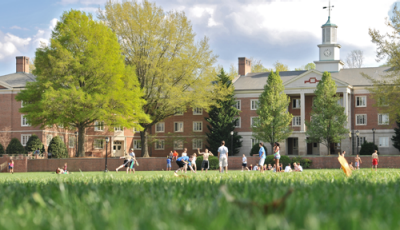Ready for Our Closeup
Washington Hall, Moffett Hall and Bondurant Auditorium are the latest buildings on campus to undergo renovations with sustainable design in mind.

Washington Hall
Washington Hall is among RU buildings that will have a new look for the next academic year. Work began this fall on the residence hall, built in 1967 and due for a face-lift. Like Madison and Jefferson halls, both updated in summer 2011, Washington will be reconfigured from a suite arrangement to one providing a private bath for each two-student room. Other improvements are to include new furniture and air conditioning.
Roy Saville, director of facilities planning and construction, said the “penthouse” area will be renovated to provide two apartments like those that have been popular in Madison and Jefferson. One will have four bedrooms and one, five bedrooms.
Throughout the remodeling, the emphasis will be on sustainable design and energy conservation. “The building’s heating and cooling will be provided by a water source heat pump system using a site-located cooling tower. This will be the first system of its type at RU.”

Bondurant Auditorium
No sooner had the final graduate left the stage of Bondurant Auditorium in May than RU Facilities Management crews swung into action to transform Bondurant Auditorium into a more modern venue for performances and special events.
“It is a big leap forward for what we can provide those who host events here,” said Doug Mead, technical director for the auditorium, which was last remodeled in 1998.
The renovation began with the removal and transfer of the auditorium’s seats to storage and with asbestos abatement measures. The console for the pipe organ, an auditorium icon, was gently removed, and a massive steel scaffolding system was installed to provide access to all parts of the ceiling. The panels in front of the organ pipes were rebuilt with oak to match a new stage facade.
Crews leveled the floor for new carpet, reinstalled the seating, replaced HVAC diffusers, painted the ceiling and replaced the house lights with high-efficiency LED lighting. Finally, the sound system in the 1,500-seat auditorium was changed from analog to state-of-the-art digital, with more than 3 miles of cable and conduit to upgrade it and the room’s electrical and network capabilities.

Moffet Hall
When Patsy South White ‘67 came to Radford in January 1966 as a transfer student, she lived in Moffett Hall, built just three years earlier.
“I thought it was a beautiful building,” she recalled. “Moffett was so brand-new. The parlors were elegant with nicely upholstered wooden furniture. It was a very gracious building.”
Completed in 1963, the residence hall was named for RU’s legendary M’Ledge Moffett, the first female dean at a public university in Virginia. Except for window replacement in the late 1990s and a partial renovation of the student health area, the building changed little in half a century.
A comprehensive makeover began in February 2011. The redesign was done by VMDO Architects of Charlottesville, and Contractor Thor Inc. of Roanoke began work immediately after commencement ceremonies in May 2011. RU Facilities Planning and Construction managed the project from start to finish.
The work began with asbestos abatement—after all, back in the 1960s, asbestos was not known as a health hazard. Then interior demolition for a new floor plan comprising mostly two-person rooms, each with its own bath, followed. Resident assistants and the resident director now have apartments on the first level, and there are four multi-bedroom student apartments on levels 2 and 3.
White shared a small first-floor room with two other young women during her first term at Radford. “There were two beds, one on each side of the window and a third against a wall. There were no bookcases and only two desks.”
As the third person assigned to the room, “I did my studying on my lap.” Nor did she have her own closet. “There were two sliding-door closets with combination locks.” While the closets could be locked, the room itself could not. “I had to hang my clothes in the other girls’ closets and memorize both combinations.”
Moffett Hall rooms have been modified over the years, and security has improved, but updates have been incremental. The renovation made radical changes reflecting 21st century construction and conservation standards.
Roy Saville, director of facilities planning and construction, said sustainability was considered in every phase of the project. For instance, existing doors were reused, and bamboo, a rapidly renewable material that can regenerate in 10 years, was used for lounge flooring and display boards adjacent to student rooms.
“Our aim was to minimize the use of new raw materials and the energy required for production and transport.”
Low-flow toilet fixtures and shower heads were installed in all bathrooms, as was the case when Madison and Jefferson residence halls were remodeled in summer 2011. The “new” Moffett Hall is cooled with a high-tech, energy-efficient chiller. It uses magnetic-bearing centrifugal technology similar to that by which maglev high-speed trains are suspended above their tracks with a magnetic field. When used for cooling, the technology slashes both costs and greenhouse gas emissions.
“This will mean huge savings on energy costs and energy usage.”
Meeting and study spaces were added throughout the building, as well as a large lounge with a kitchen on the first level and a laundry room on both the east and west wings of each level. Access inside and outside the building was improved to accommodate those with disabilities, including 11 fully accessible resident rooms. All rooms have new furniture.
Amber Mullen, director of residential life, said the conversion from suites to two-person rooms is the most notable change to the floor plan. The entire project, however, has a broader impact. “It’s modernizing the building, another step toward updating all of our residence halls for all of our students.”